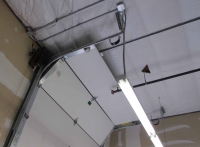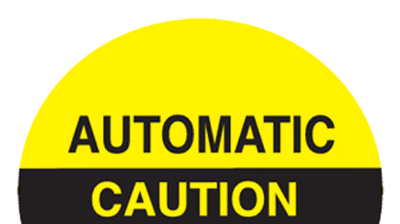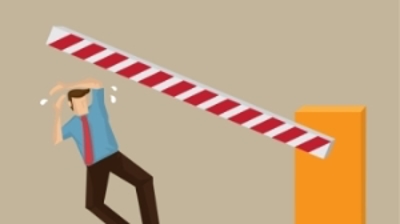COMMERCIAL OVERHEAD DOORS
Worker Injury Claims
Download pdf of this article here
By Michael Panish
Automatic Door Expert Witness
A worker is performing a duty near the ceiling within the path of travel
of an automatic overhead door. Without warning, the door begins to move
and the top edge of the door collides with the worker or what he is standing
on, causing the worker to fall to the ground.
Every situation is different. Circumstances and information provided affect the outcome of the claim. No two cases are the same and factors that pertain to one case do not always apply to another.
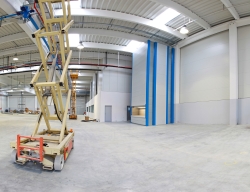 Many case scenarios involve a worker that was perched upon a ladder, scissor
lift, or some elevated platform with no fall precautions, no assistant
working at ground level monitoring him, and no usage of safety harnesses
or tie off precautions. Most safety protocols limit working above 6 feet
in height without safety restraints in place.
Many case scenarios involve a worker that was perched upon a ladder, scissor
lift, or some elevated platform with no fall precautions, no assistant
working at ground level monitoring him, and no usage of safety harnesses
or tie off precautions. Most safety protocols limit working above 6 feet
in height without safety restraints in place.
 Usually, the door has been remotely activated by another person from the
exterior, not realizing that there is somebody working within the path
of travel of the overhead doorway. In every case, the worker has fallen
off of the raised location after making direct or transferred contact
with the overhead door top edge.
Usually, the door has been remotely activated by another person from the
exterior, not realizing that there is somebody working within the path
of travel of the overhead doorway. In every case, the worker has fallen
off of the raised location after making direct or transferred contact
with the overhead door top edge.
From the perspective of a plaintiff's attorney, there should be some sort of sensor or safety edge on the top end of the overhead door, and they do not think that their clients are responsible for the incident. They usually haven't asked if their client was using an approved safety harness or appropriate fall protection when working high above the floor. Nor have they checked to ask their client if there was any consideration given to check that the door would not move when they were working in proximity to it.
Defense attorneys are seeking proof that the overhead door is within industry standards. And, hoping that their defendant or cross defendant is without blame or responsibility.
These overhead door collision injuries have occurred in a variety of environments including industrial settings, automotive bays, apartment garages, personal residences, loading dock areas, hospitals and hotels.
The overhead door industry has adopted specific standards for door safety. Included in these standards are motor controllers with specific reverse functions, safety sensors, and emergency push button controls that can completely disable an overhead door system. Slip clutches are incorporated in most motor controllers. These devices allow a specific force resistance to stop the motor controller action from either pushing or pulling the door when the set threshold is reached, depending upon the product and manufacturer.
In most cases where an overhead door upper edge made contact with an obstruction in the path of travel, these force resistance devices were functioning properly. This did not offer any protection to a worker performing services within the path of travel of the door system. The elevated platform did not offer adequate resistance to activate the slip function of the motor controller. The workman should have taken the necessary precautions to make sure that the motor controller was deactivated prior to working in that space.
Many commercial overhead doors utilize similar sensor technology to residential overhead doors, others do not. In commercial applications, there are usually more stringent safety devices in place to stop or start the movement of the overhead door system. Commercial doors are usually referred to as "trained traffic" openings. This means that most users of these doorways have been instructed as to how to properly open and close the door by the management of the facility where they are installed. Most residential overhead doorways are considered non-commercial and are generally used by "untrained traffic" where the push of a remote button is all that is needed to operate the door.
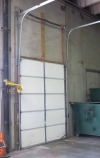 In general, commercial overhead doors are not designed to monitor or sense
the presence of an obstruction within the overhead path of travel of that
door system. Motor controllers that contain auto reverse circuits and
slip clutches are generally designed to address a downward force to prevent
crushing an obstacle in the space between the door bottom and threshold
of the system. As of this writing, there are no standards or specifications
in place that require the upward leading edge or door top to have any
additional sensory systems to prevent contact with a person perched atop
a ladder or lift in the path of travel when opening. This will probably
not change due to the fact that this type of injury claim is really a
workplace training issue, and not a door function issue.
In general, commercial overhead doors are not designed to monitor or sense
the presence of an obstruction within the overhead path of travel of that
door system. Motor controllers that contain auto reverse circuits and
slip clutches are generally designed to address a downward force to prevent
crushing an obstacle in the space between the door bottom and threshold
of the system. As of this writing, there are no standards or specifications
in place that require the upward leading edge or door top to have any
additional sensory systems to prevent contact with a person perched atop
a ladder or lift in the path of travel when opening. This will probably
not change due to the fact that this type of injury claim is really a
workplace training issue, and not a door function issue.
Would it make sense to develop a leading edge sensor or some sort of optical device to protect a workman from being hit by the top edge of a moving overhead door?
The facts are, that these types of devices already exist and the usage of these safety products for this application have limited value. In most cases, a professional trained workman is aware of the potential for door activation, and would take the necessary steps to make certain that the door cannot move while working within the path of travel of the overhead doorway. The repeated collisions that seem to be happening more frequently are the result of improperly trained workers, not defective door system designs.
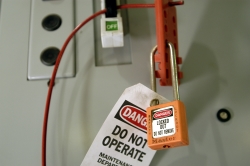 In most companies, employee training and education involves showing employees
how to safely work in any environment where their job might take them.
An example of one of the most basic safety rules involves a "lock
out and tag program". This "lock out and tag program "has
been in effect in numerous trades for decades. In this program, it is
the responsibility of any worker to make certain that any moving piece
of equipment, powered device, auto start mechanism, or (in this case)
doorway, where they will be performing their duties, cannot affect their
work space.
In most companies, employee training and education involves showing employees
how to safely work in any environment where their job might take them.
An example of one of the most basic safety rules involves a "lock
out and tag program". This "lock out and tag program "has
been in effect in numerous trades for decades. In this program, it is
the responsibility of any worker to make certain that any moving piece
of equipment, powered device, auto start mechanism, or (in this case)
doorway, where they will be performing their duties, cannot affect their
work space.
A few different trade related comparisons may make understanding this concept easier.
- If a workman were performing duct cleaning in a high rise building, there would typically be high powered fan systems that have thermostats that remotely control those fan motors. Any worker potentially subjected to that fan blade needs to know that the remotely activated motor controller is disconnected, disabled, and will not start while they are cleaning the ducts adjacent to the fan blades. Obstructions that stop the fan blades from turning are typically installed when working in this area to assure the worker that there is no possibility of an inadvertent motor start. Failure to disconnect the fan while working in the area is unsafe and potentially life threatening.
- In the case of an electrician that needs to work on a remote electrical sub-panel connected to a main service panel in a high rise building, it is common practice to "chain an electrical buss". Padlocking and placing a tag on that service panel makes everyone aware that remote work is taking place, and nobody should attempt to energize the panel without making contact with the lock key holder. When the electrician is finished working, he returns to the padlocked panel, removes the lock and card (tag), and takes the chains off of the buss. In my company, it has always been standard practice to provide an additional level of safety when working in a remote situation. An additional worker would be posted adjacent to the locked out panel to insure that there was no possibility of endangering a worker that was away from the shut-down electrical buss. This is industry standard, and this type of remote safety program applies to all trades as the need presents itself.
- Working in proximity to a moving door system without knowing that the door system is disconnected and unable to move is potentially hazardous and unsafe. This is equivalent to having an elevator repairman subjected to the movement of an elevator car if a button was pushed to call the car to another level while he was attempting to service the elevator car from inside the elevator shaft. There is no difference in the concept that a worker that is performing any duty adjacent to a moving door make certain that the door cannot be remotely activated. Failure to do so is unsafe and below occupational safety standards.
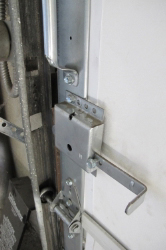 Every commercial doorway and most residential systems have some way of
disconnecting the motor controller. Some have manual disconnect buttons,
others have keyed locks. In the most primitive situation, a worker could
simply unplug the motor controller and push a slide bolt into the doorway
frame to insure that the door cannot be opened while he is working in
the door path of travel. If none of these methods are suitable, clamps
can be attached to the door frame that stop the movement of the door when
properly placed.
Every commercial doorway and most residential systems have some way of
disconnecting the motor controller. Some have manual disconnect buttons,
others have keyed locks. In the most primitive situation, a worker could
simply unplug the motor controller and push a slide bolt into the doorway
frame to insure that the door cannot be opened while he is working in
the door path of travel. If none of these methods are suitable, clamps
can be attached to the door frame that stop the movement of the door when
properly placed.
This is ultimately the individual responsibility of the worker. It may be the responsibility of the worker's employer to adequately train the worker. But in the final analysis of every jobsite injury where a worker was hit by a piece of moving equipment or automated doorway, the worker must assume the responsibility for not taking appropriate measures to make his workplace safe prior to entering that zone.
Untrained and incompetent workers are often the reason for these needless workplace injuries. There is a definite lack of professionalism in the construction trades and service industries today. Often, workers are uneducated or are not adequately instructed by the people that hire them. These untrained and unskilled workers should never have been allowed to work in these locations to begin with.
In several recent calls, attorneys have told me that the worker that was injured was the owner of the company that was providing the service. There is absolutely no excuse for an injury of this kind to occur. Simple trade standard safety precautions would have completely eliminated the hazard. Failure to do so has created frivolous claims that are generally due to lack of personal responsibility and common sense practices.
Mike Panish is the nation's leading and most active expert witness and consultant for automatic door personal injury and wrongful death cases. He is regularly retained and designated by plaintiff, defense, cross defense, door manufacturers, and door installers on all types of automatic door injury, product liability, and premises liability cases. Mike Panish is the most comprehensive and thorough automatic door expert witness in the country. Mike has authored and published many articles pertaining to automatic doors, manual doors, and door hardware. Many of his articles are becoming known as the industry standard for automatic doors and door hardware. His testimony in many cases has set standards and been included in cited references for case law.

